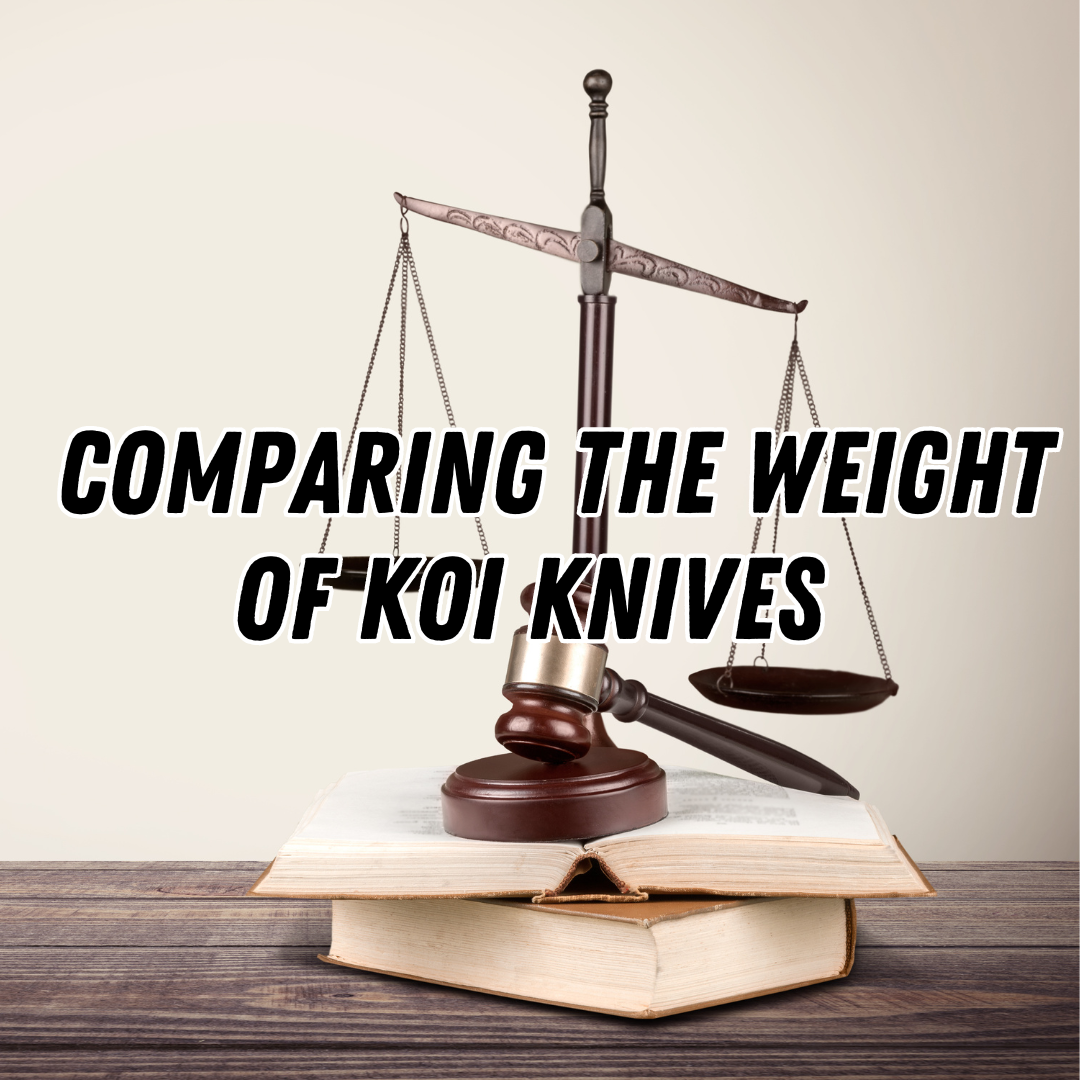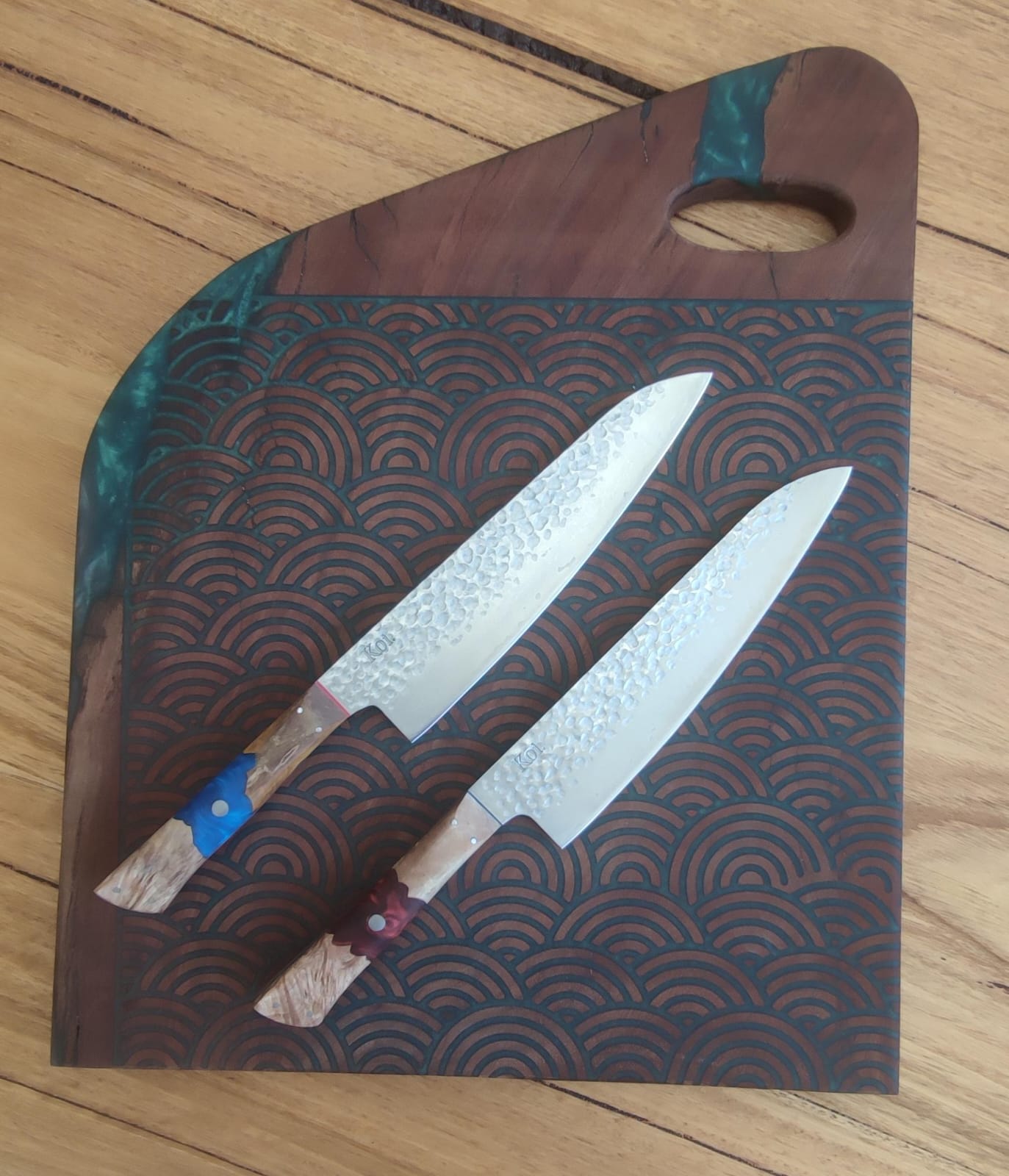Have you ever wondered how the weight of a knife could transform your kitchen experience? For those with a passion for cooking, you know that the right knife can be the difference between ordinary and extraordinary. In this exploration, we'll dive into a seemingly subtle yet remarkably significant factor – the weight of your knife.
Can you envision the perfect balance in your hand, the seamless precision through various ingredients, and the artistry that emerges in your cooking? It all commences with a keen understanding of how a knife's weight shapes your culinary experience.
Understanding Knife Weight
Think of knife weight as the heft or mass of the blade. It's like the unseen hand that guides your every slice and dice. In simpler terms, it's how heavy or light a knife feels in your hand when you pick it up. This weight, or lack thereof, affects your interaction with your knife and the ingredients you're preparing.
The Significance of Weight in Knife Performance
Now, why is this weight so significant? Well, it's all about control and precision. A heavier knife, for instance, can power through dense items like butternut pumpkin. Conversely, a lighter knife might excel at delicate tasks like slicing ripe tomatoes paper-thin.
How Knife Weight Affects Handling, Balance, and the Cutting Experience
The weight of a knife influences its balance. Imagine a seesaw; a well-balanced knife is like that perfect equilibrium point. It means the blade and the handle have the right distribution of weight. This balance can make the knife feel like an extension of your hand, leading to more comfortable and controlled cutting.
Moreover, the weight determines how much effort you must put into cutting. A heavy knife does some of the work for you, while a lighter one requires more finesse. Your preferences and tasks will guide you in choosing the ideal weight for your culinary adventures.
The Seki Collection
The Seki Collection is a testament to the artistry and craftsmanship of Japanese knife makers. It comprises six distinct knives designed to excel in specific culinary tasks. From delicate slicing to robust chopping, the Seki knives cover the entire spectrum of kitchen needs.
Detailed Description of Each Knife in the Seki Collection
- The Gyuto: This is the all-purpose workhorse akin to a chef's knife. Its 210mm blade is your go-to tool for everything, from slicing to dicing.
- The Bunka: Crafted from robust Japanese steel, the Bunka is perfect for heavy-duty tasks. Its hammered blade reduces stickiness, making it ideal for various preparations.
- The Petty: Lighter in construction, the Petty knife is your precision tool. It excels in delicate and detailed knife work, making it your ally in intricate kitchen tasks.
- The Santoku: Japan's second-most famous knife, the Santoku, is an all-purpose wonder. It does it all easily, whether chopping herbs, slicing meats or tackling pumpkin.
- The Sujihiki: If precision slicing is your game, the Sujihiki is your ace. Its long, sharp blade is ideal for carving sashimi, cured fish, or roast meats.
- The Nakiri: With "Na" meaning "vegetable" and "Kiri" meaning "to cut," the Nakiri is the ultimate vegetable chopper. It's designed to make quick work of your veggie prep.
Weight Specifications for Each Seki Knife
The weight of a knife can significantly affect its performance, and the Seki Collection is no exception. Here are the weight specifications for each knife:
- Gyuto: 205g
- Bunka: 240g
- Petty: 120g
- Santoku: 160g
- Sujihiki: 215g
- Nakiri: 180g
Insights into the Suitability of Seki Knives for Various Culinary Tasks
The Seki Collection, with its diverse set of knives, is well-suited for a wide range of culinary tasks. Whether you're preparing intricate dishes that demand precision or tackling more substantial projects, these knives have got you covered. In the following sections, we'll delve deeper into how the weight of these knives impacts their performance and helps you make the right choice for your culinary adventures.
The Rainbow/Ninja Collection
These knives are a sight in your kitchen, like a rainbow after a refreshing rain shower. Crafted with a G10 rainbow handle and VG10 Japanese Damascus steel, they perform exceptionally and add a pop of colour to your cooking space.
Detailed Description of Each Knife in the Rainbow/Ninja Collection
- The Paring Knife (Mini Chef's Knife): This handy knife, with a blade length of 210mm (8.26"), is your go-to tool for precision tasks like peeling and coring. Its weight of 226g (7.23oz) strikes the perfect balance between control and utility.
- The Petty Knife (Small Chef's Knife): With a similar weight and blade length as the Paring Knife, the Petty Knife excels at small chopping tasks and intricate cutting.
- The Kiritsuke Knife (K-tip Chef's Knife): This versatile knife, with a blade length of 210mm (8.26"), is a workhorse in the kitchen, offering precision and power.
- The Gyuto Knife (Chef's Knife): The Gyuto, with a weight of 226g (7.23oz) and a blade length of 210mm (8.26"), is your trusty all-purpose kitchen companion.
- The Pankiri (Serrated Bread Knife): Perfect for bread, pastries, and delicate cake layers, this knife is designed for effortless slicing.
- The Nakiri (Vegetable Chopper): With its 240g (8.46oz) weight and 170mm (6.69") blade, the Nakiri makes quick work of vegetable prep.
Weight Specifications for Each Rainbow/Ninja Knife
Each knife in the Rainbow/Ninja collection is designed precisely. They all weigh in the range of 226g (7.23oz) to 242g (8.53oz), providing a comfortable heft that enhances control while cutting.
Comparing the Rainbow/Ninja Knives' Weight to Other Collections
Compared to other collections, Rainbow/Ninja knives strike a balance between lightness and heft. This balance makes them versatile tools suitable for various culinary tasks.
Advantages and Considerations of Using Rainbow/Ninja Knives
The Rainbow/Ninja collection's knives bring a splash of colour to your kitchen and deliver exceptional performance. Their weight provides stability without being cumbersome. Whether you're a seasoned chef or a home cook, these knives offer precision and style in every slice.
The Yokohama Collection
Yokohama collection – a trio of knives designed to elevate your culinary adventures. These carefully crafted knives are the perfect companions for any aspiring home cook or seasoned chef.
Yokohama Collection Introduction
The Yokohama collection embodies simplicity, functionality, and elegance. Each knife in this set is a testament to the artistry of Japanese knife craftsmanship. With their Japanese steel blades and ergonomic handles, they're not just tools; they're extensions of your culinary passion.
Detailed Descriptions
- Yokohama Petty Knife - With its 150mm blade, this knife is ideal for precise slicing. It's perfect for delicate tasks like slicing strawberries or deveining shrimp.
- Yokohama Gyuto Knife - The Gyuto, featuring a 210mm blade, is a versatile all-purpose knife, perfect for chopping, slicing, and dicing.
- Yokohama Bunka Knife - The Bunka knife, with its 185mm blade, is a powerhouse designed for versatile and heavy-duty chopping. It's your go-to for tackling those challenging ingredients.
Weight Specifications:
- Petty Knife: 193g (6.81oz)
- Gyuto Knife: 242g (8.53oz)
- Bunka Knife: 260g (9.17oz)
Comparing Weights
Compared to other collections, the Yokohama knives offer a balanced weight that's neither too heavy nor too light. This balance ensures precise control without sacrificing cutting power.
Suitability for Culinary Tasks
The Yokohama knives excel in various culinary tasks. The Petty Knife's precision is perfect for sushi and sashimi. The Gyuto's versatility makes it your everyday workhorse. The Bunka Knife handles heavy-duty jobs with ease, from chopping to mincing.
Conclusion: Comparing Knife Weight Across Collections
Seki Collection knives offer versatility and precision. Their balanced weight allows for delicate and intricate tasks while handling more robust cutting when needed.
The Rainbow/Ninja Collection is known for its lightweight agility. These knives are perfect for those who prefer a nimble, responsive tool in the kitchen.
In contrast, the Yokohama Collection strikes a balance between the two, providing the weight necessary for stability in heavy-duty tasks without sacrificing manoeuvrability.
Ultimately, the "best" knife collection for you depends on your cooking style and preferences. If you love a do-it-all knife, Seki might be your go-to. If precision and speed are your priorities, consider Rainbow/Ninja. For those who want a bit of both worlds, Yokohama might be the sweet spot.
Your knife should feel like an extension of your hand, enhancing your culinary journey. Happy cooking!




